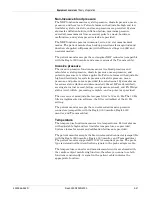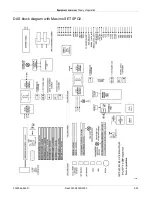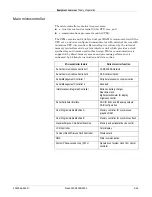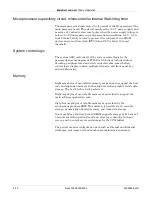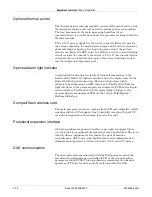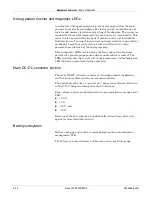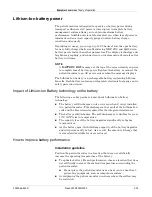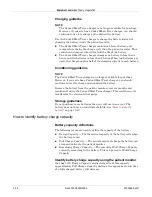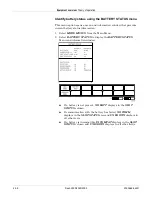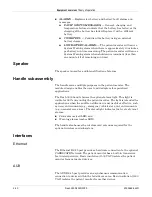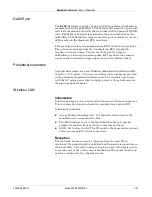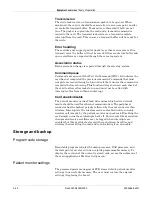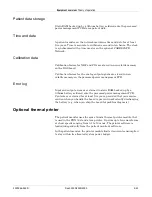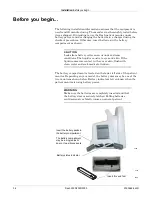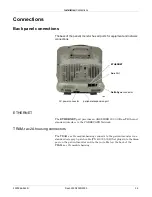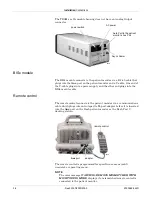
Equipment overview:
Theory of operation
2000966-542D
Dash 3000/4000/5000
2-35
Lithium-Ion battery power
The patient monitor is designed to operate on battery power during
transport or whenever AC power is interrupted. A complete battery
management system allows you to obtain maximum battery
performance. Audible and visual alarms alert you when loss of power is
imminent and on-screen capacity gauges indicate battery charge
condition and capacity.
Depending on usage, you can get up to 2.5 hours of run time per battery
for new, fully-charged batteries. Monitoring NBP, CO2 and SpO2 drain
battery power faster than other parameters. The display technology and
brightness, graphing, and connection to a wireless network can also alter
battery run times.
NOTE
A
BATTERY LOW
message at the top of the screen warns you prior
to complete loss of battery power. Replace the battery or connect the
patient monitor to an AC power source when the message displays.
The Lithium-Ion battery is a rechargeable battery containing Lithium-
Ion cells. Each battery contains an integrated electronic fuel gauge and a
safety protection circuit.
Impact of Lithium-Ion Battery technology on the battery
The following are key points to know about Lithium-Ion battery
technology:
The battery self-discharges on its own, even when it is not installed
in a patient monitor. This discharge is the result of the Lithium-Ion
cells and the bias current required for the integrated electronics.
The battery self-discharges. The self-discharge rate doubles for every
10°C (18°F) rise in temperature.
The capacity loss of the battery degrades significantly at higher
temperatures.
As the battery ages, the full-charge capacity of the battery degrades
and will permanently be lost. As a result, the amount of charge that
is stored and available for use is reduced.
How to improve battery performance
Installation guideline
Position the patient monitor in a location that does not artificially
increase the operating temperature of the battery.
To optimize battery life and performance, choose a location that does
not
artificially increase the ambient temperature surrounding the
patient monitor.
Do not place the patient monitor near a heat vent or near heat-
generating equipment, such as computer monitors.
Avoid placing the patient monitor in corners where the airflow may
be restricted.
Содержание 001C 051D 003A
Страница 10: ...viii Dash 3000 4000 5000 2000966 542D ...
Страница 11: ...2000966 542D Dash 3000 4000 5000 1 1 1 Introduction ...
Страница 20: ...Introduction Service information 1 10 Dash 3000 4000 5000 2000966 542D ...
Страница 21: ...2000966 542D Dash 3000 4000 5000 2 1 2 Equipment overview ...
Страница 64: ...Equipment overview Theory of operation 2 44 Dash 3000 4000 5000 2000966 542D ...
Страница 65: ...2000966 542D Dash 3000 4000 5000 3 1 3 Installation ...
Страница 73: ...2000966 542D Dash 3000 4000 5000 4 1 4 Configuration ...
Страница 99: ...2000966 542D Dash 3000 4000 5000 5 1 5 Preventive maintenance ...
Страница 116: ...Preventive maintenance Clear the stored patient data memory 5 18 Dash 3000 4000 5000 2000966 542D ...
Страница 117: ...2000966 542D Dash 3000 4000 5000 6 1 6 Troubleshooting ...
Страница 146: ...Troubleshooting Wireless LAN 6 30 Dash 3000 4000 5000 2000966 542D ...
Страница 147: ...2000966 542D Dash 3000 4000 5000 7 1 7 Field replaceable units ...
Страница 201: ...2000966 542D Dash 3000 4000 5000 8 1 8 Functional and electrical safety checks ...
Страница 256: ...Functional and electrical safety checks Checkout procedures completion 8 56 Dash 3000 4000 5000 2000966 542D ...
Страница 257: ...2000966 542D Dash 3000 4000 5000 A 1 A Electromagnetic compatibility EMC ...
Страница 267: ...2000966 542D Dash 3000 4000 5000 B 1 B Network troubleshooting ...
Страница 273: ...2000966 542D Dash 3000 4000 5000 C 1 C Network disclosure to facilitate network risk management ...
Страница 279: ...2000966 542D Dash 3000 4000 5000 D 1 D Checklist ...
Страница 281: ......

